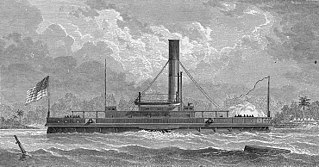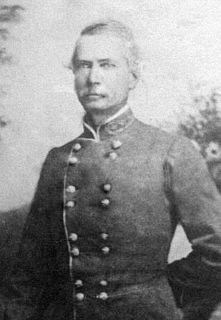
The first USS Ellen was a side-wheel steam gunboat in the United States Navy during the American Civil War.

The Battle of Secessionville was fought on June 16, 1862, during the American Civil War. Confederate forces defeated the Union's only attempt to capture Charleston, South Carolina, by land.
The 198th Signal Battalion is an Expeditionary Signal Battalion in the Delaware Army National Guard. Delaware is known as the "First State," as referenced in their motto "First Regiment of First State." The unit specializes in command post node communications, providing broadband satellite voice and data connections for brigade sized battlefield elements. The unit includes Headquarters, Headquarters Company located in Wilmington, DE; A Company in Georgetown, DE; B Company in Hodges, SC; and C Company in Wilmington, DE.

Hampton's Legion was an American Civil War military unit of the Confederate States of America, organized and partially financed by wealthy South Carolina planter Wade Hampton III. Initially composed of infantry, cavalry, and artillery battalions, elements of Hampton's Legion participated in virtually every major campaign in the Eastern Theater, from the first to the last battle.

The Second Battle of Charleston Harbor, also known as the Siege of Charleston Harbor, Siege of Fort Wagner, or Battle of Morris Island, took place during the American Civil War in the late summer of 1863 between a combined U.S. Army/Navy force and the Confederate defenses of Charleston, South Carolina.

James Heyward Trapier was a career United States Army officer who fought during the Mexican–American War. He also served as a Confederate general during the American Civil War, dying shortly after its conclusion.

The 4th South Carolina Cavalry Regiment was a regiment of cavalry in the Confederate States Army during the American Civil War. They were from the state of South Carolina and served primarily in the Eastern Theater of the American Civil War. The 4th South Carolina Cavalry Regiment was organized on December 16, 1862, by consolidating the 10th Battalion South Carolina Cavalry, the 12th Battalion South Carolina Cavalry, the Charleston Light Dragoons and Company A of the St. James Mounted Riflemen. The 10th Cavalry Battalion was organized in the spring of 1862 with five companies, and Major James P. Adams and Major William Stokes were the commanding officers. The 12th Cavalry Battalion had also been known as the 4th Cavalry Battalion.
The Pointe Coupee Artillery was a Confederate Louisiana artillery unit in the American Civil War made up primarily of men from the parishes of Pointe Coupee, East Baton Rouge, Livingston and other surrounding parishes as well as a large number of men from New Orleans.
The Pee Dee Light Artillery was a distinguished Confederate light artillery battery during the American Civil War. The origins of the battery began as the Darlington Guards, a local militia of Darlington, South Carolina. The Darlington Guards volunteered their service to South Carolina on January 4, 1861, for a period of six months. These men were the very first soldiers to volunteer to fight in Civil War. They became Company B, First South Carolina Volunteers, commanded by Captain F.F. Warley and Lieutenant David Gregg McIntosh. After six months on the Charleston, South Carolina, coast and a short campaign in Virginia, the unit was released. Half the unit remained with Captain Warley and served the remainder of the war as the Darlington Guards. The other half reformed in Darlington, South Carolina, under McIntosh. The unit called themselves the Pee Dee Rifles and in August 1861 rendered their service as an infantry unit to the Confederate States of America for the duration of the war. While in training in Suffolk, Virginia, in the winter of 1861-62, the unit was reorganized as Company D, First South Carolina Regiment, a light artillery battery, and became the Pee Dee Light Artillery.

The Second Battle of Pocotaligo, or Battle of Pocotaligo Bridge, or Battle of Yemassee, often referred to as simply the Battle of Pocotaligo, was a battle in the American Civil War on October 22, 1862 near Yemassee, South Carolina. The Union objective was to sever the Charleston and Savannah Railroad and thus isolate Charleston, South Carolina.
Reid's Arkansas Battery (1862), was a Confederate artillery battery that served during the American Civil War. Another Arkansas battery, the 1st Arkansas Light Artillery, a.k.a. the Fort Smith Artillery, was also once known as "Reid's Battery". Captain Reid had commanded the Fort Smith Artillery during the Battle of Wilson's Creek, but left that organization and later organized a second battery that is the subject of this article.
The Battle of James Island was a minor skirmish near the end of the American Civil War. It was known as the "Last fight for Charleston".
Major Nicholas Bayard Clinch was a commander in the army of Confederate States of America during the American Civil War, as well as a planter and inventor.
The 24th South Carolina Infantry Regiment was a Confederate infantry regiment in the American Civil War.

3rd Rhode Island Heavy Artillery was a heavy artillery regiment that served in the Union Army during the American Civil War.
The Battle of Legareville was fought on December 25, 1863, during the American Civil War. Confederate forces tried to surprise Union forces near Legareville on Johns Island but failed to destroy the federal forces or drive them away from Legareville.
The Battle of The Pineberry Battery was a series of minor engagements, fought April 29, 1862, in Charleston County, South Carolina, during the American Civil War. The engagements proceeded from an attack by the Union Navy on a battery on John Berkeley Grimball's plantation on Edisto Island. After successfully destroying the battery, the ship was attacked twice by Confederate artillery forces before returning to its station. The attack was a part of Union efforts to secure Edisto Island, which housed a large colony of escaped African Americans and served as a launching point of a campaign against Charleston.

The 10th South Carolina Infantry Regiment was a Confederate volunteer infantry unit from the state of South Carolina during the American Civil War. It fought with the Army of Tennessee in the Western Theater for the duration of the war. Originally organized to serve for twelve months it was reorganized for the war in 1862. Sent east to fight in the Carolinas Campaign in 1865 it was consolidated with the 19th South Carolina Infantry Regiment and formed Walker's Battalion, South Carolina Infantry. The unit surrendered with General Joseph E. Johnston and the Army of Tennessee at Bennett Place on April 26, 1865. Out of 2189 men listed on the regimental muster rolls throughout the conflict only 55 enlisted men remained to be paroled.
The 118th Field Artillery Regiment is a field artillery regiment of the Georgia Army National Guard. The regiment's 1st Battalion is the cannon battalion assigned to the 48th Infantry Brigade Combat Team.













